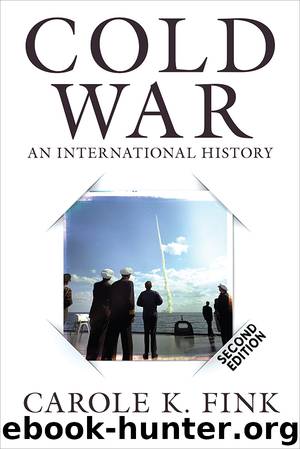Cold War by Fink Carole K.;

Author:Fink, Carole K.;
Language: eng
Format: epub
Publisher: Routledge
Published: 2018-10-22T16:00:00+00:00
Vietnam
The Vietnam War remained the most critical issue in US-Soviet relations. Early in the Nixon administration, the president had signaled that these could not improve without Soviet aid in ending the war and had threatened to escalate hostilities if this was not forthcoming. The Soviets, while acknowledging their limited control over Hanoi, resented US pressure and the use of its opening to China to force them to stand aside.*
Nixon did fulfill his 1968 campaign promise to end the draft and reduce the number of US troops in Vietnam, but he also escalated the amount of violence and casualties. Far exceeding Johnson’s approach, Nixon’s moves included expanding the war into Cambodia in 1970 and into Laos in 1971 (destabilizing both countries) and responding to every North Vietnamese offensive with massive bombing attacks. Nonetheless, the United States failed to budge Hanoi at the meeting table. In the secret Paris talks that he directed after 1969, Kissinger failed to win North Vietnamese agreement on a mutual withdrawal of their forces from South Vietnam.
Facing reelection in 1972, Nixon stepped up the pressure on Moscow. In April Kissinger punished the Soviets’ complicity in Hanoi’s recent offensive by refusing to facilitate the passage of the two Eastern treaties in the West German Bundestag. Nixon’s badgering had some effect. At the May 1972 Moscow summit Brezhnev finally agreed to send an emissary to Hanoi, and during the fall and winter of 1972 both of Nixon’s summit partners urged restraint on their client. Hanoi responded by accusing China and the Soviet Union of becoming bogged down on “the dark, muddy road of compromise.” North Vietnam denounced its two patrons—“lured by the chimera of peaceful coexistence and economic benefits”—for betraying “the great, all-conquering revolutionary idea of the age.”
The United States wielded its military power. Kissinger’s announcement that “peace is at hand” undoubtedly contributed to Nixon’s reelection in November 1972; but immediately afterward the president ordered the December bombing raids on Hanoi and Haiphong that forced North Vietnam to return to the conference table and to agree to the country’s continuing division. With the agreement on January 27, 1973, America’s long, costly, and divisive war ended on a sour note with a cease-fire in place instead of a total North Vietnamese withdrawal.* Within two years, the Saigon government—weakened by the complete removal of US troops and a sharp decrease in US military aid—was overcome by North Vietnamese forces. In the spring of 1975 the governments of Cambodia and Laos also fell to the communists, leading to civil war, genocide, and Hanoi’s intervention in both countries.†
The conclusion of the Vietnam War underscored the paradox of US-Soviet détente that had been complicated by the emerging US-Sino-Soviet triangle. Although the Superpowers had committed substantial resources to the struggle in Southeast Asia, neither had fully controlled its clients. Both had expected the other to be more accommodating than either was willing to be, or even capable of being. To be sure, Hanoi’s victory in 1975 created more diplomatic and economic problems for Moscow as
Download
This site does not store any files on its server. We only index and link to content provided by other sites. Please contact the content providers to delete copyright contents if any and email us, we'll remove relevant links or contents immediately.
| Africa | Americas |
| Arctic & Antarctica | Asia |
| Australia & Oceania | Europe |
| Middle East | Russia |
| United States | World |
| Ancient Civilizations | Military |
| Historical Study & Educational Resources |
Cat's cradle by Kurt Vonnegut(14768)
Pimp by Iceberg Slim(13787)
Underground: A Human History of the Worlds Beneath Our Feet by Will Hunt(11841)
4 3 2 1: A Novel by Paul Auster(11800)
The Radium Girls by Kate Moore(11626)
Wiseguy by Nicholas Pileggi(5323)
American History Stories, Volume III (Yesterday's Classics) by Pratt Mara L(5139)
Perfect Rhythm by Jae(5075)
The Fire Next Time by James Baldwin(5024)
Paper Towns by Green John(4805)
Pale Blue Dot by Carl Sagan(4626)
A Higher Loyalty: Truth, Lies, and Leadership by James Comey(4555)
The Mayflower and the Pilgrims' New World by Nathaniel Philbrick(4285)
The Doomsday Machine by Daniel Ellsberg(4250)
Killers of the Flower Moon: The Osage Murders and the Birth of the FBI by David Grann(4192)
Too Much and Not the Mood by Durga Chew-Bose(4097)
The Sympathizer by Viet Thanh Nguyen(4096)
The Borden Murders by Sarah Miller(4025)
Sticky Fingers by Joe Hagan(3916)
